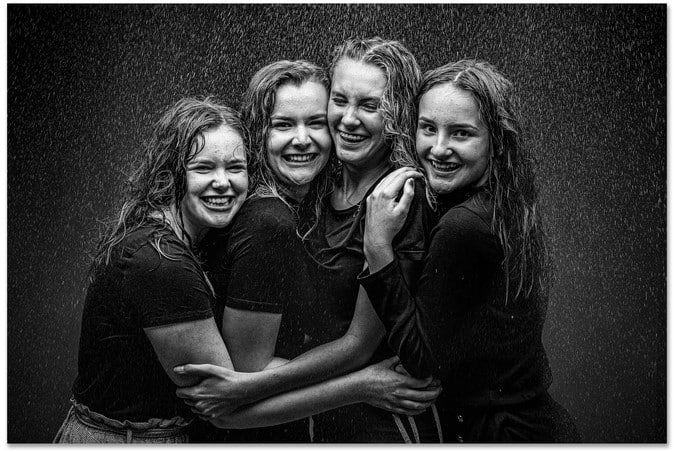
This is from a magazine interview, which was also picked up by the most recent Master Photographers magazine.
The story behind GWS Photography and especially the award winning WET SHOOTS !
Just Add Water !
Award-winning Scottish photographer Grahame Smith reveals how he’s tapped into an elemental new form of portraiture and how training, mentoring and dedication has helped shape a very successful photography business, and how now – is himself a trainer / mentor to new and up and coming photographers from all over the UK.
Not quite the overnight success as Grahame’s photography experience goes back to the early 1980’s – but it’s since “switching on” in 2016 that has seen him earn many awards and qualifications – culminating to be invited on as a judge in this year’s Master Photographers awards.
But first The Wet Shoots – the story behind these amazing portraits…
It’s fair to say that Grahame Smith is making a splash with these stunning portraits. And he’s doing so with a deceptively simple recipe: just add water.
Grahame, who runs GWS Photography in Dunbar, East Lothian with wife Allison, describes his wet shoots as ‘the ultimate in unique and personal portraits’. Looking at the panel of remarkable photographs which earned him his MPA Fellowship, you couldn’t disagree.
As you might expect from the name, wet shoots involve lining subjects up, pouring water over them, and capturing their reactions. People respond to being doused in water with a range of spontaneous and undeniably human emotions. Some seem to revel in the refreshment. Others grimace with shock, and one or two look like they are about to reach over and thump their photographer!
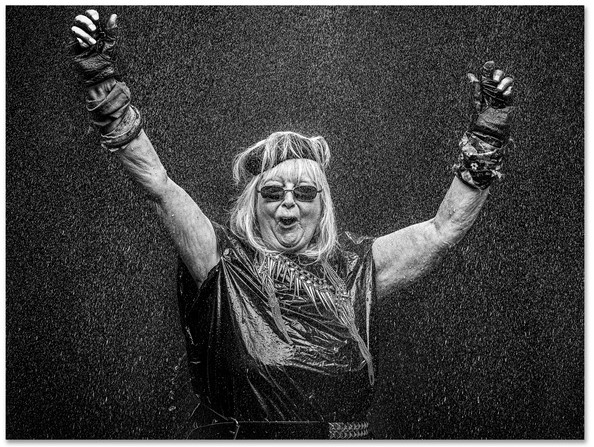
Every subject goes through three stages on a wet shoot, Grahame says, which you might summarise as surprised stoicism, acceptance and enjoyment, and finally: ‘Get me out of here!’ One man, who appears in a trio of his panel pictures, is a perfect example. “He’s the guy with a cigarette in his mouth – which was lit. We watched it slowly fall apart. He thought he was quite tough.
“He then took his top off, and was standing there almost naked. And the guy with the hand on his face? That’s him again, when he got brain freeze!”
…we’ve got something pretty special here…
Where did the concept come from?
“I’ve always had this idea of being at a wedding, and the bride’s soaking wet – having this emotional picture of a couple so in love that nothing on this earth will dampen their attachment. Love through adversity. The photo I always imagined as the perfect version of this would be a stark – almost high key black and white image, a couple in a tight embrace – soaking wet in the rain – but fiercely in love.
I was really keen to exploit this ideal – but it had to start somewhere else – somewhere with more control – so we planned to bring the rain into the studio.” Grahame said.
He decided to give it a go. The only problem was, it was November. In Scotland. Take the subjects outside and hose them down, and you might end up with a super-quick case of hypothermia. “In the end we decided, let’s just shoot it inside, and test the idea.”
Among his first volunteers – or as he jokingly calls them, his victims – were members of a local band who wanted to get some publicity photos but hadn’t any money. “I said, ‘I’ll do your pictures for you, but you’ll have to do something for me.’ And so we got to hose them down and test the idea out.
“As soon as we did it, we thought – we’ve got something pretty special here.”
The water prompts involuntary, instinctive reactions and helps to uncover the real person being photographed, Grahame says. “The girls especially would still try and pose. But within a few seconds, they were giving us a real emotional look. They were squealing or laughing.”
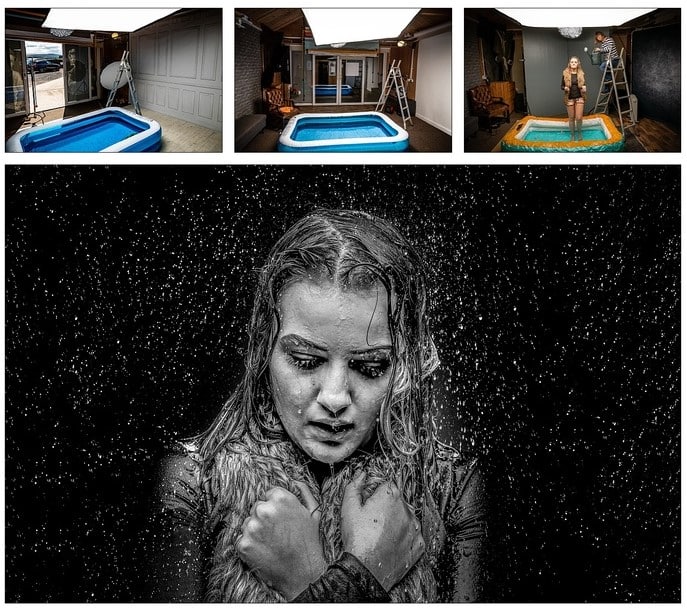
Very quickly it starts to get uncomfortable. “At that point we stop. It’s a very fast shoot to do. There’s about 15 minutes explaining the process. Once they’re under the hose and under the lights, we’re probably lucky if there’s two or three minutes – and that’s it done.”
From those first shoots, Grahame has refined the technique. It began with his wife Allison using a watering can; those early shots have far fewer droplets in the image as a result. “We thought, we need more power, we need to soak them even more. So we now have our own garden hose with an extension plugged into our studio kitchen tap.”
They get through a lot of Argos paddling pools to capture the water. Battery-powered lights remove the need for cables, keeping things safe. “The main light is in a huge, fixed softbox which gives that nice wide look. It lives permanently in the studio ceiling, being lowered slightly for the Wet Shoots from a home made pully system.,” Grahame explained.
“It’s as crude as Allison being up a ladder with a hose and a sprinkler – and the person is just at the edge of the light, so the light comes down in front of them.”
He gives his subjects some guidance on what to wear (and reminds them to bring a change of clothes of course). “One of the girls is wearing my dad’s old raincoat, because I wanted this weird, manly look.”
To capture the water in such detail involved some trial and error. “I did experiment with high-speed sync, to freeze the water in the image more. But it actually spoiled it.” He now always uses a shutter speed of 1/200th of a second. Similarly, he learned that traditional lighting techniques don’t always work. “In a lot of the pictures, there’s no catch light in the eye. In a competition scenario, that could lose you points.
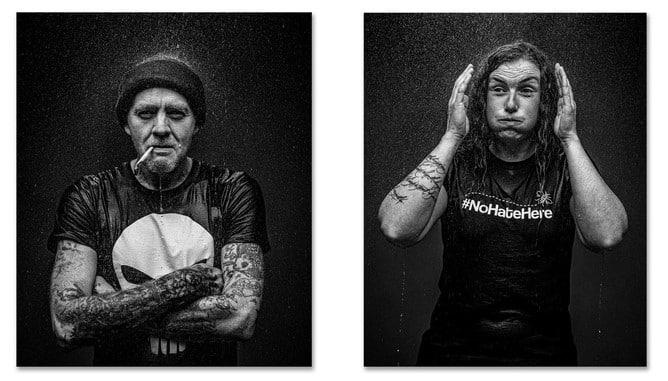
“For a few of the shoots in the early days, I put a flashgun behind me so there was just a twinkle in the eye. But it ruined those pictures – because they look better when they’re soulless.
“The ones with catch lights in the eyes, they were almost like a normal picture, just somebody was a wee bit wet. Whereas the ones with the dark, deep eyes, they look like they’ve been out in a major, night-time thunderstorm. And that was the whole point, to make it look like a movie.”
They’ve shot about 40 wet shoots now – he uses a Canon 5D Mk IV, with a 24-70mm lens – and there’s a waiting list. People are persuaded to sign up by the quality of the results, Grahame says. They’ve started to take the concept outside too. “We had an outdoors shoot booked with three sisters two weeks ago – and it got rained off,” he says. “Because it was so wet outside, our lights would have got ruined. So I actually had a wet shoot rained off, which was a bit ironic.”
And has the idea taken off ? “Yes… way better than ever planned. When we had shot about 5 or 6 Wets, and viewed the finished images together – you could see the power in the work – the body of photographs is amazing to see, and we knew it was something special. And now people are booking it as an alternative portrait session. It’s amazing handing over 30” acrylics of the finished shoot, knowing that anyone who sees this photo on our client’s wall will be like “WOW!!!”.
“It was incredible to be awarded the Fellowship”, Grahame said. “Doing the wet shoots, I could see the power of it as a panel. You never know for definite, but because I’ve been doing mentoring for licentiates (and now Associates) , you get an idea of what works in a panel.”
“I was still delighted and a little bit surprised to get it. It’s only afterwards, when I look back at the full work together, that you can see that, yeah, that is pretty powerful.”
So what next for the Wet Shoots ?
“We’re at the early stages of planning a Celebrity Wet Shoot book for charity. Watch this space on that one… and now we are also booking in lots of individuals and groups that see what we are doing is different – a wee bit Rock ‘n Roll.
We had a group of 5 girls in recently for a birthday treat for one of them, some treat – hosed down with freezing water 😊 But their results are looking incredible.”
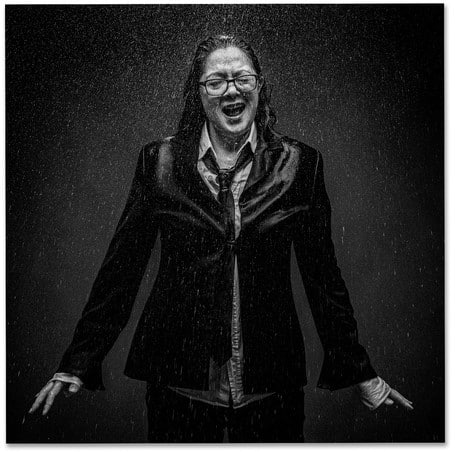
Grahame’s interest in photography came through his dad. “I used to pick up my dad’s old 110 and 126 cameras, and just snap around the house. And then in the Eighties I got more into it and I started shooting all the local bands, and doing all their posters.”
In 1982 he joined the RAF, and applied to be a force photographer “but I was told I was overqualified”, so he was cajoled into being an aircraft technician instead. Because of the change in trade he lost interest in both the RAF and photography for a few years, until seeing the growth in home videos and starting a wedding video service.
He didn’t pick up a camera again properly until around 1995. But at that time it was more of a hobby than a real desire to do it professionally.
Then from around 2002 Grahame would sell some of his landscape photographs from his High Street shop in Dunbar.
“I used to love the stress burner of landscape photography – and the thrill of people wanting to buy them was nice. But then out of the blue I got an urge to do more portraits – and at the same time I was very kindly offered a “studio space” in Saddlers – a local café run by David Main. He offered it to me for free. Amazing. And it’s from those days I just fell in love creating portraits. That’s what makes me tick – people. Whether it’s a posed and formal portrait – or a street photograph with someone doing something random – it’s people.
Every photo is unique. Everyone is unique !”
Grahame then started GWS Photography in 2010, specialising in weddings,portraits and pets. Later he “seriously switched on” to wanting to learn more about photography, and became fully engaged with the MPA. “That’s when our business has taken off, and every year it’s getting better and better”.
As well as seeing sales rise, “it’s given us that freedom to feel that we can be creative and do this kind of thing. And the Fellowship was like the final tick in the box to say, ‘you do realise that you are pretty good at this now?’”
He says the mentorship offered by the MPA “helps immensely. It’s an incredible thing to get someone who can give you a real, honest opinion”. He won his first award in the Scottish MPA region in 2016 in the ‘reportage wedding’ category – plus a win in the ‘open’ category for “a very scary picture of a doll in a pram in an old hospital”.
Grahame is now a mentor himself. “I love it. I love being able to put something back.”
“Too many people get into photography, get told by friends they are good and then try to start out professionally. Most fail.
Not because they are bad photographers, but because they haven’t put together the full package.
Business, working with people and the photography.
Very few people have the natural ability to start making money in photography. Some are great photographers and very bad at business, others not so amazing photographers but are brilliant at business and marketing. It’s those ones that will survive.
That’s not good for the industry as we get flooded with not so good photographers.
I reckon I could teach the technical bits of photography to anyone in a few weeks… but getting someone to grasp the concept of a photography business is no overnight thing.”
“And that’s where the modern approach fails. Too many people want success, awards and big spending clients straight away. It doesn’t work like that.
Best thing anyone can do is to have a photography mentor that you can share photos with for genuine critique. Not Facebook friends saying “wow” and “stunning” but getting real advice from a photographer that has been around for years.
They will be able to help with the business aspect too.
I have a mentor, I’ve had 3 or 4 going back through the last 5 years. The guys I speak to for help and advice have been around the industry for many years, and they have many famous clients.
But too many new photographers just want success now, and don’t want to be told their work needs to improve, or their approach to business needs tweaked.
Be humble, be honest and get good advice. If you live off Youtube videos and social media likes, all you have is an expensive hobby.
Grahame and Allison have worked for themselves since 2002. With no income other than that from the photography business it means everything has to be perfect.
“We work 7 days a week usually, not always in the studio, but we’re always changing & adapting. The current pandemic is a great example of learning to adapt and move. Many photography studios are struggling all over the UK, but we’re booked out 2 months in advance… but that’s because we work our buts off in the background.”
“But we wouldn’t have it any other way. We love the industry, the friends we have within The Master Photographers Association and doing what we love.
To be able to get up every day and create something special for somebody is such a thrill. It could be a family, some kids or someone’s dog – but we get to stop and think about what we can do for this shoot ?”
Grahame finishes on a touching note… “My Dad passed away just a few years back, just as we opened the new studio, and the last thing he wrote to me was a Good Luck card, in it he wrote ‘To the hardest working couple I know… ‘ but to be honest – it doesn’t seem like hard work when you enjoy it so much.”
That card sits proudly in our awards display cabinet, and means more to Grahame than any of the trophies in there.

